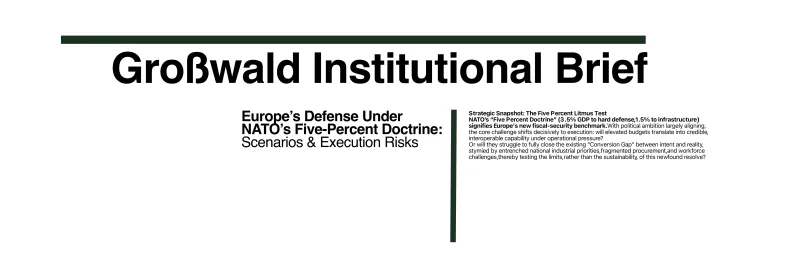Axis of Circumvention: Strategic Implications of the Russia–Iran–North Korea Nexus
Russia’s wartime partnerships with Iran and North Korea enable weapons transfers, sanctions evasion, and cross-domain disruption. This Großwald analysis unpacks the implications for NATO, Germany’s Bundeswehr, and the fragile architecture of deterrence in 2025.


Introduction
Russia’s full-scale invasion of Ukraine in 2022 catalyzed a profound realignment in the global security architecture. Facing unprecedented sanctions and military attrition, Moscow has turned to pariah partnerships to sustain its war economy and expand its geopolitical leverage. Chief among these: Iran and North Korea—two sanctioned regimes with compatible interests, converging threat perceptions, and reciprocal needs.
This report synthesizes developments across this emergent trilateral axis, analyzing its operational relevance, material exchanges, and strategic implications for NATO and European defense. It also outlines the Bundeswehr’s evolving doctrinal response within the alliance framework.
Russia’s Sanctions Evasion Through Pariah Partnerships
The reconfiguration of Russia’s strategic dependencies is most visible in its growing reliance on Iran and North Korea. This triangle is transactional, but not trivial—it has allowed Moscow to bypass defense shortfalls and reinforce pressure on Ukraine.
Iran: Moscow’s Drone Arsenal and Beyond
Since mid-2022, Iran has emerged as a key military supplier to Russia. The Shahed-131/136 loitering munitions—rebranded as Geran-1/2 by Russian forces—have played a persistent role in striking Ukrainian infrastructure. Beyond drones, Western intelligence assessments suggest Tehran has considered transferring short-range ballistic systems like the Fateh-110 or Fath-360, despite public denials.
In return, Iran has gained access to Russian military technologies previously out of reach. Reports point to cooperation on air defense, satellite infrastructure, and even missile telemetry derived from battlefield-tested Russian platforms in Ukraine. Notably, engineers from both countries have been involved in co-production initiatives, including Shahed drone assembly in Russia’s Tatarstan region.
Parallel to these exchanges, Iran has brokered discreet dialogues between Russia and regional actors such as Yemen’s Houthis—reportedly facilitating interest in P-800 Oniks anti-ship missiles. This could signal a Russian intent to escalate maritime disruption in the Red Sea corridor.
North Korea: Artillery for Technology
North Korea’s role has rapidly evolved from political support to kinetic contribution. U.S. officials assert that Pyongyang has transferred millions of artillery shells to Russia, compensating for Moscow’s dwindling domestic production. In exchange, Kim Jong Un is pursuing Russian assistance for satellite launches and missile platform development.
During his September 2023 visit to Russia’s Vostochny Cosmodrome, Kim secured potential cooperation on military reconnaissance satellites and long-range ballistic systems. Russian expertise offers Pyongyang rare access to space-enabling technologies amid tightening Chinese restraint.
This growing alignment also reflects a North Korean effort to diversify away from overdependence on China. While China remains its economic lifeline, engagement with Russia provides geopolitical leverage and access to dual-use technologies that are otherwise off-limits under UN sanctions.
Strategic Fragility: A Marriage of Convenience
Despite the visible momentum, the Russia–Iran–North Korea triangle is inherently fragile. It is underpinned not by ideology but by overlapping strategic interests in defying Western pressure.
- Iran seeks sanctions relief and nuclear diplomacy with the West while deepening military ties with Russia.
- North Korea trades artillery for tech but is under constant pressure from international isolation and internal economic fragility.
- Russia remains the pivot—desperate for supplies, but also the sole partner offering substantive technology transfers.
This alignment can deliver tactical advantages but lacks structural cohesion or long-term guarantees. It is vulnerable to diplomatic disruption, economic pressure, and shifting threat perceptions.
NATO and Bundeswehr Response: Rebuilding Resilience
The strategic convergence of these actors has catalyzed a decisive posture shift within NATO. At the 2023 Vilnius Summit, allies committed to rearming and reinforcing the eastern flank, with Germany pledging a permanent combat brigade in Lithuania.
This marks a significant evolution for the Bundeswehr, signaling a turn away from expeditionary stabilization toward collective territorial defense. The pivot is doctrinal and material:
Leadership as a Capability
German Defense Minister Boris Pistorius has emphasized the importance of Führungsfähigkeit—leadership capability—as a central tenet of readiness. This encompasses the ability to command, coordinate, and operate effectively under resource constraints, in alliance-integrated contexts.
Multi-Domain Operations (MDO)
Facing adversaries capable of hybrid and cross-domain warfare, NATO’s doctrine now centers on MDO. This strategy integrates effects across five domains—land, air, maritime, cyber, and space—enhanced by digital synchronization and civilian-military cooperation.
Key pillars include:
- Multinational Leadership: Defense efforts must be embedded in NATO and EU frameworks.
- Cross-Domain Integration: Command structures must support effects-based planning beyond single-domain logic.
- Cooperative Civil–Military Ecosystems: Industry, civil defense, and public institutions must be integral to national resilience.
Germany’s OpArch FühFa Bw (Operational Architecture Leadership Capability) exemplifies this shift, modeling leadership and interoperability processes in a digital twin environment for doctrinal refinement and capability alignment.
Diplomatic Leverage: Managing the Triangle
While deterrence and rearmament are essential, NATO must also explore the seams of the Russia–Iran–North Korea partnership. Strategic engagement opportunities persist:
- Iran remains ambivalent, balancing ties with Russia against potential reentry into nuclear negotiations. Exploiting this duality could fragment Moscow–Tehran military ties.
- North Korea is isolated and economically brittle. Offers of food, health aid, or phased sanction relief could shape Pyongyang’s calculus—if tied to measurable security concessions.
Conclusion:
The emergence of a Russia–Iran–North Korea axis represents a serious, though unstable, challenge to global security norms. This partnership enables weapons transfers, sanctions evasion, and cross-domain disruption—but it is also a coalition of necessity.
To navigate this threat environment, NATO must combine hard deterrence with flexible diplomacy. Germany’s shift toward forward presence and MDO integration is a critical step. So too is the West’s ability to apply calibrated pressure that fractures these transactional partnerships rather than reinforcing them.
Structured Intelligence Series
This article forms part of Großwald's ongoing series examining hostile state alignments, defense adaptation, and cross-domain operational architectures. For more intelligence briefs, explore more reporting from our Großwald Policy Desk:






